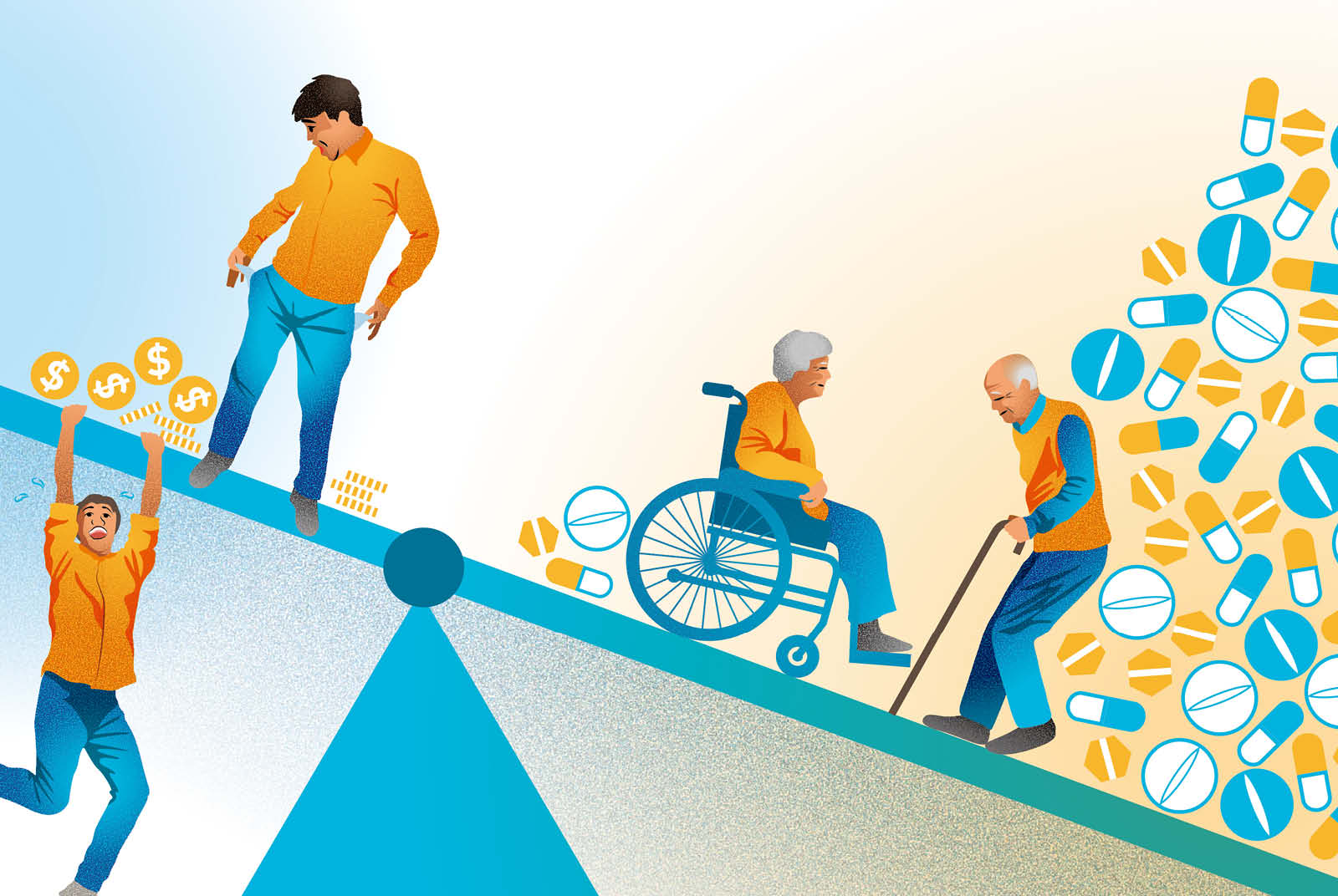How can Taiwan’s National Health Insurance program be saved?

Source:CommonWealth Magazine
It has been almost 30 years since Taiwan instituted its National Health Insurance (NHI) program. On average, the Taiwanese visit doctors 18 times a year, but more of them are dying from diabetes than the Japanese or Koreans. The NHI is perpetually in the red, driving up costs for the patients, but they aren't getting healthier. What needs to change?
Views
How can Taiwan’s National Health Insurance program be saved?
By Sydney Peng, Yu-Ching Chouweb only
Yoon Kim, Professor at Seoul National University College of Medicine, spoke with CommonWealth via video call on March. 8th, two days before he ran for a seat in Korea's National Assembly as a representative of the Democratic Alliance of Korea.
He's entering politics because "Korea is staring down the barrel of a major healthcare crisis. On top of a chronic shortage of doctors, the entire system has become deformed. For example, the ballooning self-pay sector will have a lasting negative impact," he said.
He pointed out that many Korean doctors make nearly a third of their income from self-pay items in the healthcare system. But the government's lack of oversight is a pressing problem that he hopes he can fix from the inside.
 Korean medical professions went on street striking. (Source: Getty Images)
Korean medical professions went on street striking. (Source: Getty Images)
For Taiwan, looking at Korea's looming healthcare crisis is like staring into a mirror. Taiwan's National Health Insurance (NHI) has also reached a point where key reforms are necessary.
Korea's National Health Insurance Service (NHIS) was established in 2000, just five years after Taiwan set up its NHI. Both systems are mandatory and allow insurees the freedom to choose their own doctors. The only difference is that the NHI adopted a global budget payment system, while the NHIS failed to push this through due to fierce opposition from doctors.
Taiwan's global budget system is running healthcare into the ground
The meaning of a global budget payment system is that the annual healthcare expenditure ceiling is tied to the country’s population.
In nearly 30 years, the NHI's premium has only increased three times, and it has decreased twice. It's also bolstered by "Second-Generation NHI", which stipulates a fixed annual premium contribution from the central government. In contrast, the NHIS has increased its premium and payments to hospitals every year except for three since its conception.
The difference in the two countries' healthcare quality is plain to see after 24 years of traveling in opposite directions.
The Taiwanese government points to the Numbeo Health Care Index, which has ranked Taiwan’s healthcare system as being number one in the world for six consecutive years, as proof that there’s nothing to fret about. But research by Dr. Ming-Shiang Wu (吳明賢), director of National Taiwan University Hospital (NTUH), shows that the index only takes factors like the condition of medical equipment and the average length of waiting time into account. While this may reflect the availability and convenience of healthcare services, it doesn’t tell us much about the quality of care.
"We get high marks for affordability and availability, but that doesn't mean we are receiving good care," says Wu.
Average life expectancy in Taiwan used to be longer than Korea. Now Koreans live 83.5 years on average, while Taiwanese only live 81.3 years.
Impact #1: High mortality rates from diabetes, myocardial infarction
More and more data is showing that the quality of care given to patients with critical illnesses and chronic conditions is stuck in a rut.
Diabetes is a clear example. Taiwanese are dying from it two times more than Koreans and seven times more than Japanese.
This is because more and more Taiwanese have diabetes, but this is a chronic condition that requires long-term integrated care—which the current system was not designed to deliver.
The government is aware that diabetic patients require care from a "shared care network" of interdisciplinary professionals, including physicians, nurses, counselors, and nutritionists, who can help keep track of the patients' condition over the long term. But less than 40% of Taiwanese diabetics are receiving such care.
Take Ms. Wu, a 27-year-old diabetic. For a decade, she's struggled with controlling her blood sugar. Her insulin dosages have been increasing.
She urgently needs assistance from nutritionists, but they only work during the day and she also needs to go to work. Some clinics are open in the evening, but only one in ten are part of the shared care network.
Chen Hung-lin (陳宏麟), chairman of Taiwan Medical Clinics Association, says the real reason is because the premium for the NHI has not increased in more than 20 years. "Care for chronic illnesses takes a lot of time and money, so hospitals are reluctant to participate."
Another pressing issue is care for patients with critical conditions. More than ten thousand Taiwanese suffer from heart attacks every year. According to The BMJ, a medical journal, a comparison between insurance policies in six countries shows that Taiwanese sufferers of acute myocardial infarction have much higher 30-day and 1-year mortality rates than American or European patients.

The problem lies not in immediate resuscitation, but what happens afterwards.
According to Dr. Wu of NTUH, well-trained medical professionals are needed to staff ICUs around the clock. "But how will under-funded hospitals be able to afford such talent?"
Chun-Yao Huang (黃群耀), Chairman of Taiwan Myocardial Infarction Society, says that heart attack mortalities have been steadily on the rise since 2007. It's currently plateaued at 50 deaths per 100,000 people. Lack of long-term care after the first attack and patients not returning to doctors for regular checkups are the two main reasons why the mortality rate is not coming down.
Impact #2: Super-aged societies need more investment and a fee-for-service system
Another downside to the global budget ceiling is that it delays the entry of new drugs and treatments into Taiwan. This is in addition to the cap it puts on medical personnel compensation and the quality of care that's available to patients with chronic or acute medical conditions.
"On the surface, it's medical professionals getting less pay, but this is really about the health of everyone in the country," says Taiwan Medical Association Standing Director Wang Fong-Yu (王宏育).
As the name implies, a super-aged society is one in which a shrinking number of working citizens must pay for an increasing number of senior citizens. The current system is unsustainable. While Korea is struggling to rein in spending, Taiwan must expand investment and improve healthcare quality.
What will the cost of inaction be? Dr. Lo Yung-ta (羅永達), director at Ching-Chyuan Hospital, has participated in multiple budget ceiling negotiations. He thinks things will start to come to a head after 2025. As baby boomers like him enter retirement, income for the NHI will drop to a historic low. Without swift reform, the younger generation will shoulder a heavy burden.
Taiwan’s medical community is united in their call for more investment in the sector. Taiwan’s current health expenditure (CHE) is only 6.1% of the GDP, far less than that of Japan or Korea.
Nicole Huang (黃心苑), Professor and Chair at the Institute of Hospital and Health Care Administration at National Yang Ming Chiao Tung University, says that developed countries spend around 10% of GDP on average on healthcare. Taiwan needs to expand its investment.
But where will the money come from? As president-elect, Lai Ching-te has his work cut out for him.
Unshackling the budget ceiling will be the first step. Taiwanese citizens also need to understand that you get what you pay for, and right now they’re not paying enough for healthcare.
The NHI’s premium rate is legally capped at 6%. The current rate is 5.17%. Hsing-wen Han (韓幸紋), a member of the National Health Insurance Committee, estimates that the cap will be reached by 2028 at the latest. At that point, the NHI might become unsustainable.
Raising the premium rate is one of many options. Hung Tzu-jen (洪子仁), head of the Taiwan College of Healthcare Executive (TCHE), thinks that a diversified approach is what’s needed. Multiple channels of income can be considered for the NHI. The central government can foot a bigger percentage of the bill, or the government can allocate spending to the NHI.
Shou-Hsia Cheng (鄭守夏), Dean of the College of Public Health at National Taiwan University and former Director General at the National Health Insurance Administration, has analyzed Taiwan’s and Korea’s health insurance systems for many years. He points out that the Korean healthcare system has more money because the people as well as the government are willing to pay more.
Tragedy of the commons: 18 hospital visits a year
What brings us back to Korean doctor-turned-politician Yoon Kim. His observation is that the two countries face similar problems. Not only is the distribution of medical resources unbalanced, “the fiercely competitive market means that patients can go to medical centers with the most minor complaints.”
Both Taiwan and Korea are trying to focus medical resources on those who are really in need. Currently, 70% of the NHI’s budget is spent on consultation and 30% is spent on hospital stays. In comparison, other countries usually spend around 55% on hospital stays. “Taiwan’s system gets more revenue from consultation rather than long-term hospital stays. This is why the payment system is in a dire situation,” says Po-Chang Lee (李伯璋), former Director General of Taiwan’s Ministry of Health and Welfare.
The root of the problem is, since citizens have the right to choose their own doctors, and since hospitals get paid per consultation, the hospitals end up making all their money from consulting. Sometimes, they even recommend consultation when it’s clearly unnecessary.

On average, Taiwanese visit hospitals 18 times a year, while Koreans visit hospitals 16 times a year. Both figures are more than double that of the OECD average.
The Ministry of Health and Welfare calculates that if average visits every year decreased by one per person—that is, 17 visits a year—it would put NT$40 billion back into the budget.
The payment system is in urgent need of a fix. Lo thinks that if Taiwan was serious about making its citizens healthier, “the capitation system is the last option to consider.”
Capitation prioritizes prevention over care
Under the capitation system, everyone is assigned to a healthcare provider to which they pay a fixed annual amount. Lo explains that this will encourage doctors to “want patients to be healthy, because each additional visit cuts into their profit.”
Of course, the prerequisite of such a system is that there is a sufficient budget for the NHI. Also, patients will no longer be free to choose their own doctors and visit big medical centers for minor complaints. “Otherwise, it would be a disaster,’ warns Wang.
The ideal healthcare system places the responsibility for maintaining good health in the hands of private citizens or their employers. Such a system does not provide unlimited medical care.
How to make such a system work is something Taiwan will have to think about as it moves closer and closer to becoming a super-aged society.
Have you read?
- Why so few women in Taiwan use their frozen eggs
- One-third of Taiwanese men will face cancer at some point in their lives
- Even as Birth Rates Decline, Overpopulation Remains a Global Challenge
- The Fertility Effect of National Health Insurance in Taiwan
Translated by Jack Chou
Edited by TC Lin
Uploaded by Ian Huang






